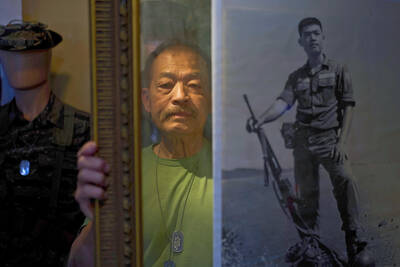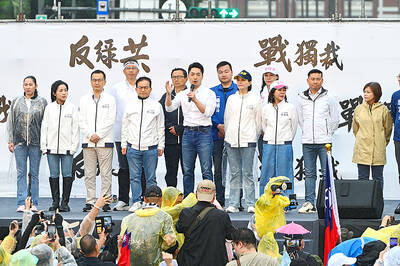Hsu Ming-jen (許銘仁) depicts the natural beauty and scenery surrounding Grass Mountain Village in his solo show On the Other Side of the Landscape (在風景的彼岸). Hsu says he used drawing as his medium in this series because it “illustrates my thoughts and observations for its direct and basic quality.” The clean and blurred lines of these images mirror the artist’s ideas about the monumentality of mountains and the mysterious landscapes that blanket them.
■ Grass Mountain Artist Village (草山國際藝術村), 92 Hudi Rd, Taipei City (台北市湖底路92 號). Open Wednesdays to Sundays from 10am to 4pm. Tel: (02) 2862-2404. Opens Saturdays at 11am
■ Until July 25
Taiwan’s fishing ports, farm scenes and village life are among the rich and vibrant landscapes seen in the retrospective exhibit of Chen Bo-wen (陳博文), The Beauty of Taiwan — A Memorial Exhibition of the Art of Chen Bo-wen (展現台灣風情 — 陳博文創作紀念展). In addition to Chen’s realist paintings, the exhibition includes sketches from his notebooks and extracts of writing that shed light on his artistic philosophy in a show that illustrates not only the artist’s achievements but also his profound love for his native land.
■ National Museum of History (國立歷史博物館), 49 Nanhai Rd, Taipei City (台北市南海路49號). Open Tuesdays to Sundays from 10am to 6pm. Tel: (02) 2361-0270. General admission: NT$30
■ Until July 25
Pale human heads emerging from the throat of verdant green frogs and an emaciated flying horse with its front half in the form of the torso of a naked woman are among the surrealist figures found in Japanese painter Tomohiro Takagi’s solo show Fur — Away. Takagi’s unusual and highly original paintings playfully depict the relationship between humans and nature, while also offering warnings about environmental destruction.
■ Elsa Art Gallery (雲清藝術中心), 3F, 1-1 Tianmu E Rd, Taipei City (台北市天母東路1-1號3樓). Open daily from 1pm to 7pm, closed Mondays and Tuesdays. Tel: (02) 2876-0386
■ Until July 18
Tripolar — 3 Positions in German Video Art presents six works by three German artists, Robert Seidel, Max Hattler and Daniel Burkhardt, working in video. The show attempts to map the characteristics of German video art and its evolution over the past several decades. The exhibition is also screening Taipei Impressions, a video meditation on the artists’ one-week sojourn to Taipei.
■ Museum of Contemporary Art, Taipei (MOCA, Taipei), 39 Changan W Rd, Taipei City (台北市長安西路39號). Open Tuesdays to Sundays from 10am to 6pm. Tel: (02) 2552-3721. General admission: NT$50
■ Until July 18
Chinese-born German artist Zhang Qikai (張奇開) examines the perceived discordant relationship between East and West in Mr Panda’s Wonderland (Mr.熊貓的魔法時空). Employing China’s iconic panda as an emblem of the spiritual quest to find true meaning, Zhang’s realistic paintings juxtapose the materialistic aspirations of the West, symbolized, for example, by diamonds, dice and poker cards, with the spiritual longings of an artist far from home.
■ Metaphysical Art Gallery (形而上畫廊), 7F, 219, Dunhua S Rd Sec 1, Taipei City (台北市敦化南路一段219號7樓). Open Tuesdays to Sundays from 11am to 6:30pm. Tel: (02) 2711-0055
■ Until June 30

As we live longer, our risk of cognitive impairment is increasing. How can we delay the onset of symptoms? Do we have to give up every indulgence or can small changes make a difference? We asked neurologists for tips on how to keep our brains healthy for life. TAKE CARE OF YOUR HEALTH “All of the sensible things that apply to bodily health apply to brain health,” says Suzanne O’Sullivan, a consultant in neurology at the National Hospital for Neurology and Neurosurgery in London, and the author of The Age of Diagnosis. “When you’re 20, you can get away with absolute

When the South Vietnamese capital of Saigon fell to the North Vietnamese forces 50 years ago this week, it prompted a mass exodus of some 2 million people — hundreds of thousands fleeing perilously on small boats across open water to escape the communist regime. Many ultimately settled in Southern California’s Orange County in an area now known as “Little Saigon,” not far from Marine Corps Base Camp Pendleton, where the first refugees were airlifted upon reaching the US. The diaspora now also has significant populations in Virginia, Texas and Washington state, as well as in countries including France and Australia.

On April 17, Chinese Nationalist Party (KMT) Chairman Eric Chu (朱立倫) launched a bold campaign to revive and revitalize the KMT base by calling for an impromptu rally at the Taipei prosecutor’s offices to protest recent arrests of KMT recall campaigners over allegations of forgery and fraud involving signatures of dead voters. The protest had no time to apply for permits and was illegal, but that played into the sense of opposition grievance at alleged weaponization of the judiciary by the Democratic Progressive Party (DPP) to “annihilate” the opposition parties. Blamed for faltering recall campaigns and faced with a KMT chair

A police station in the historic sailors’ quarter of the Belgian port of Antwerp is surrounded by sex workers’ neon-lit red-light windows. The station in the Villa Tinto complex is a symbol of the push to make sex work safer in Belgium, which boasts some of Europe’s most liberal laws — although there are still widespread abuses and exploitation. Since December, Belgium’s sex workers can access legal protections and labor rights, such as paid leave, like any other profession. They welcome the changes. “I’m not a victim, I chose to work here and I like what I’m doing,” said Kiana, 32, as she